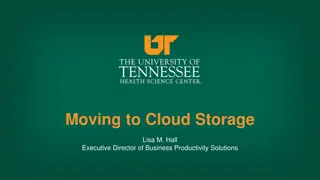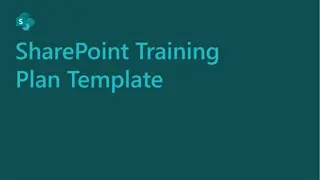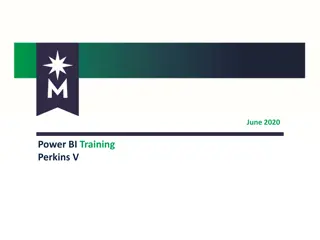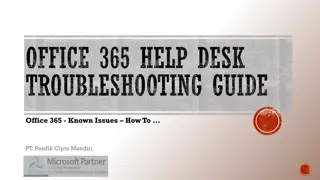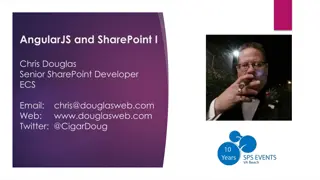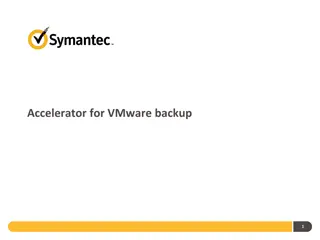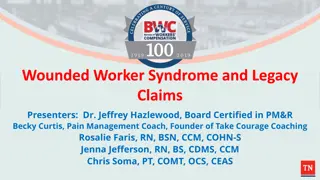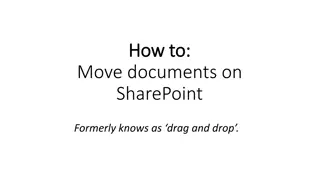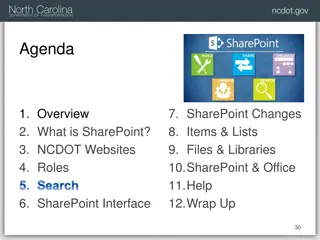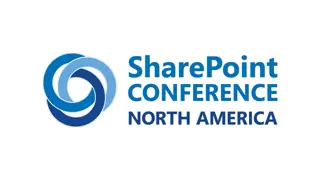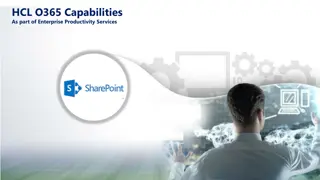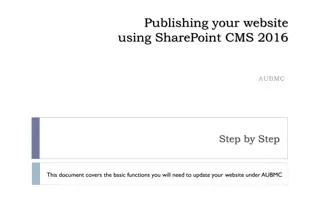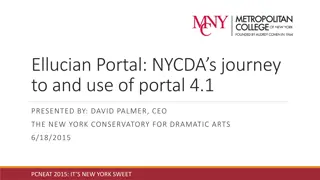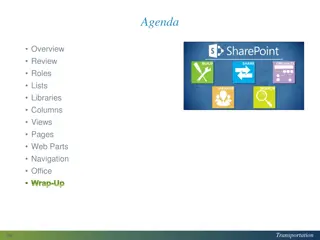Understanding SharePoint Development with Becky Bertram
Delve into the world of SharePoint development with expert Becky Bertram as she covers SharePoint features, solutions, development tools, Visual Studio 2010 integration, and various ways to interact with SharePoint. Explore the concept of features in SharePoint, their scopes, reusability, and activation dependencies for effective development practices.
Download Presentation

Please find below an Image/Link to download the presentation.
The content on the website is provided AS IS for your information and personal use only. It may not be sold, licensed, or shared on other websites without obtaining consent from the author. Download presentation by click this link. If you encounter any issues during the download, it is possible that the publisher has removed the file from their server.
E N D
Presentation Transcript
St. Louis Day of Dot Net 2011 Jump Start: SharePoint Development Becky Bertram Independent SharePoint Consultant SharePoint MVP, MCSD.NET, MCTS www.beckybertram.com @beckybertram
SharePoint Six-in-One The information in this presentation is condensed from chapters 7 and 8, authored by myself, in SharePoint 2010 Six-in-One , published by Wrox.
Topics What is a SharePoint feature? What is a SharePoint solution? What are my development tools? Using Visual Studio 2010 with SharePoint Ways of interacting with SharePoint: CAML Server Object Model Client Object Model LINQ to SharePoint REST SharePoint Web Services
What is a SharePoint Feature? A unit of functionality within SharePoint that can be turned on, or activated . Hard to describe because it can be essentially any piece of functionality in SharePoint. You could write a feature to: Add a site column, content type, or list to a site. Add an item to a list Start a timer job. Kick off a workflow Add a web part to a page Etc.
Scope 4 different scopes: Farm, Web Application, Site Collection, Site A feature can be activated only once per item at the given scope. (For instance, a feature scoped to the Site Collection level could be activated in both the HR and IT site collections, but it could only be activated once in the HR site collection and activated only once in the IT site collection.) Examples: Feature that deploys a master page would be scoped to Site Collection level, while feature that adds a particular document library to a site could be scoped to the Site level.
Reusability Because features can be reused, you ensure that the exact same behavior will happen in the exact same way across farms, web applications, site collections, or sites, (as opposed to using a tool like SharePoint Designer, or making the change in the browser, where human error could accidentally make a mistake).
Activation Dependency Features can be dependent on one another, which means one feature cannot be activated until another feature has been activated first. Example: I have one feature scoped to the Site Collection level called My List Def that deploys a custom list definition to the site collection called My Custom List. I have another feature scoped to the Site level, called My List , which, when activated, creates an instance of My Custom List in the local site. The My List feature is dependenton the My List Def feature.
Feature Activation/Deactivation Features can be activated or deactivated via the browser or by using PowerShell
Feature Folder Each feature contains a folder that includes files related to that feature: Element files (ASPX pages, images, etc.) Element manifest files (tell SharePoint what to do with element files, such as add an item to a list) Feature manifest (Feature.xml tells SharePoint which element manifest files to execute, as well as properties of the feature, such as its name and scope)
What is a Solution? A solution package is just a cabinet file with an extension of WSP. A solution is a mechanism for deploying assets to your SharePoint server farm. Assets: assembly, files, features Manifest: solution properties, assembly location, feature location, web.config changes Solutions work across a load balanced farm.
Solutions and Features Solutions can contain references to features. Example: I have a feature called My Web Part that includes a compiled web part. When activated, the feature adds that web part to the Web Part Gallery of the site collection. The solution package would contain: a reference to the feature manifest file the assembly used by the web part an instruction that the web.config must be updated to tell SharePoint that it s okay to use that web part s assembly (i.e. mark the web part type as safe ).
Sandboxed vs. Farm Solutions Farm solutions deploy assets to the server file system and assemblies are executed from within the web server process. Sandboxed solutions are extracted and run within their own separate sandboxed process, and are thus safer. Sandboxed solutions have reduced functionality, but are safer to use when the site is co-located. Sandboxed solutions can be deployed by site administrators, whereas farm solutions must be deployed by server admins. Resource throttling prevents rogue sandboxed solutions from chewing up server resources. Farm solutions added to server via PowerShell (or STSADM tool), deployed via PowerShell or Central Admin. Sandboxed solutions uploaded to Solutions Gallery, deployed from there.
Customization vs. Development Customization involves making changes to a particular site collection or site, usually by means of a tool like SharePoint Designer, or via the web browser. Development involves the creation of solution packages, features, etc., which can be used repeatedly in different environments. Developers utilize a tool like Visual Studio.
Visual Studio 2010 Visual Studio 2010 must be used to build SharePoint 2010 applications. You can use Visual Studio 2010 to build SharePoint 2007 solution packages, but you still have to do the manual work to compile the packages. Visual Studio 2010 comes with a number of built in project templates that can serve as a starting point for building SharePoint solutions. Built-in debugging functionality
VS Third Party Add-Ons SharePoint Power Tools: http://visualstudiogallery.msdn.microsoft.com/ 8e602a8c-6714-4549-9e95-f3700344b0d9/ CKS-Dev: http://cksdev.codeplex.com/
DEMO: CREATING A SOLUTION PACKAGE
DEVELOPING FOR SHAREPOINT
CAML Collaborative Application Markup Language Gives instructions telling SharePoint how to add assets to the content database. Adding an item to a list (including adding items to libraries) Adding a list or library to a site Adding a content type or site column to a site Can also be used to retrieve items from the content database much like a SQL query, using where , sort by and group by clauses . This is called a CAML Query.
CAML Example <Field Type="Choice" Group="My Custom Columns" DisplayName="Fiscal Quarter" Name="FiscalQuarter" ID="{0DFD4BB2-DBC8-461b-8A2E-E7E5D077F679}"> <CHOICES> <CHOICE>Q1</CHOICE> <CHOICE>Q2</CHOICE> <CHOICE>Q3</CHOICE> <CHOICE>Q4</CHOICE> </CHOICES> </Field>
Server Side Object Model Many of the core classes are contained in the Microsoft.SharePoint.dll assembly, and the Microsoft.SharePoint namespace. Core classes often start with SP , such as: SPFarm SPWebApplication SPSite (site collection) SPWeb (site) SPList SPListItem
SSOM Hierarchy The hierarchy of objects is fairly intuitive; each item contains a collection of lesser items, and each item can access its parent item.
Client-side Object Model Used to access SharePoint from a location outside of the SharePoint environment 3 CSOM API s: Client-side API for running code in a .NET 3.5 (or higher) managed code application Silverlight API ECMAScript API (i.e. javascript) Executes commands in batches, so as to reduce round-trips to server
CSOM Example (Client-side API) using System; using Microsoft.SharePoint.Client; ClientContext ctxt = new ClientContext("http://intranet/"); Web marketingSubsite = ctxt.Web; ctxt.Load(marketingSubsite); ctxt.ExecuteQuery(); string siteTitle = marketingSubsite.Title; ListCollection lists = marketingSubsite.Lists; ctxt.Load(lists); ctxt.ExecuteQuery(); marketingSubsite.Title = "New Title"; marketingSubsite.Update(); ctxt.ExecuteQuery(); string newTitle = marketingSubsite.Title; Console.WriteLine(lists.Count.ToString()); Console.WriteLine(newTitle);
LINQ to SharePoint Provides a way of querying SharePoint in assemblies using SQL-like syntax and strongly-typed classes. Must use the SPMetal.exe tool to generate entity classes. Example: If you have a list called Customers with two columns: First Name and Last Name , the entity classes generated would allow you to access the list using an object called Customers, which would contain a collection of Customer objects. You could access the value stored in the First Name column by using the Customer.FirstName property, etc.
RESTful Interface REpresentational State Transfer interface Uses HTTP operations of POST, GET, PUT and DELETE to interact with SharePoint data. Allows you to use URLs to retrieve data from SharePoint remotely, by appending /_vti_bin/ListData.svc to your site URL. Examples: Retrieves the title of the second item in the Accounting site s Documents list: http://intranet/sites/accounting/_vti_bin/ListData.svc/Documents (2)/Title Returns an XML-formatted list of documents from the document library where the title of the document is My Document : http://intranet/sites/accounting/_vti_bin/ListData.svc/Documents ?filter=Title eq My Document
SharePoint Web Services Fairly neglected in SP2010, since goal was to get people to use the CSOM instead of web services to access SharePoint. Web services are found in the /_vti_bin directory of your web application. Like REST, append URL of web service to current site to get data from that site. For example, you can retrieve list data from the HR site by accessing http://intranet/sites/HR/_vti_bin/Lists.asmx. You can use the Lists web service to pass in query information via XML, which will in turn return an XML-formatted list of list data.





